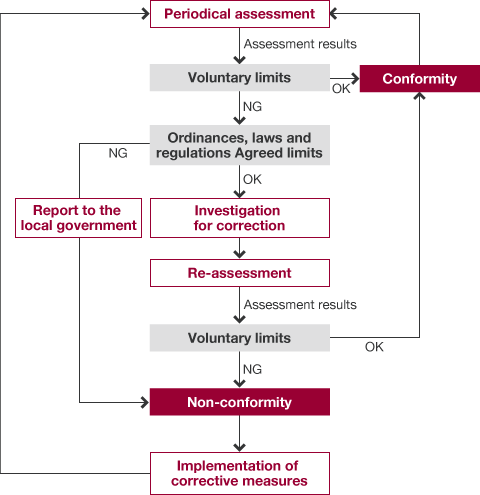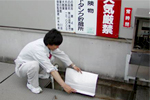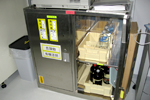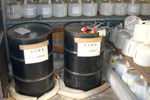 网页内容展示
网页内容展示

Basic policy for environmental risk management
One of our corporate responsibilities is reducing our environmental footprint and preventing environmental pollution or other environmental risks. At Advantest Group, we operate, and monitor and assess the environmental impact of, equipment that may affect the environment based on our own voluntary limits, which are tougher than the legal requirements.
In addition, to ensure prompt responses to accidents, we have developed rules and a management system to respond to environmental risks. These include operation manuals for equipment and chemical substance emergency procedures.
Moreover, for employees and contractors engaged in particularly high risk operations, we regularly provide special training and emergency drills so that they can act quickly in emergency situations.
As a result of these initiatives, we had no environmental accidents or complaints during fiscal 2011.
Business location compliance management

Emergency drills and test scenarios

Emergency drill
The Advantest Group prepares and follows operational manuals for equipment and tasks with high environmental risks. As of March 2012, no major accidents have occurred.
During fiscal 2011 at the Gunma R&D Center, emergency drills and test scenarios that include drill time targets were prepared with the aim of responding even more promptly in response to environmental risks. For example, if mistakes are made when oil is supplied to underground tanks and an oil leak results, there is the risk of the leaked oil flowing into the drainage structure and polluting the environment outside our business premises. To prevent an increase in environmental pollution, effective countermeasures must be put into place before the leaked oil flows into the drainage structure. To address this issue, in addition to our standard emergency drills, we have conducted tests to see whether these countermeasures are actually effective. First, in a test using water in place of oil, the time until the liquid flows into the drainage structure and the time it takes for the countermeasures to become effective were measured to establish the amount of time required for accident prevention. Afterwards, it was verified where the emergency response device should be installed to ensure prompt completion of the countermeasures, and emergency drills and test scenarios were conducted with the shortest routes and target times clearly defined.
We plan to roll out this initiative to domestic business locations during fiscal 2012 as we work to strengthen risk management.
Basic policy for chemical substance management
We are working to ensure safety management and compliance with laws and regulations in the use and storage of chemical substances used at business locations at the Advantest Group.
To this end, we have adopted a chemical substance management system. Based on this system, chemical substances are registered, safety reviews are conducted, design that supports input/output control and laws and regulations is adopted, and the material safety data sheets (MSDS) that are necessary for the safe handling of chemical substance have been made available for inspection at any time.
In addition, for strengthened risk management and chemicals substance management, we are constructing a safety training system, and conducting audits and providing guidance through the corporate chemical management division to ensure the safety of stored chemical substances to further enhance our safety control system.
Furthermore, we plan to build up our global management system as we aim to achieve the same level of risk management overseas as in Japan.
Strengthened chemical substance management

Strict chemical management

Container-by-container
management
Our chemical substance management system is capable of container-by-container control of chemicals, as well as flexible control in accordance with the control level required for each substance by various laws, such as the Pollutant Release and Transfer Registers (PRTR Act), Poisonous and Deleterious Substances Control Act, and Industrial Safety and Health Act. We also provided safety training to all relevant personnel including employees who handle chemical substances on a daily basis. The training provides basic knowledge on the hazards and toxicity associated with each chemical substance, using Material Safety Data Sheets (MSDS) and visual aids developed specifically for chemical substance management training. This extensive safety training has resulted in increased safety awareness among users and intensified management at each site.
Advantest introduced a new chemical substance management system based on hazard levels in fiscal 2011 to tighten and enhance the efficiency of controls for chemical substance safety. Chemical substances are classified into four categories depending on the degree of danger and hazard they pose, and managed according to the new standards revised for each level (such as locked storage, input/output control, periodical inventory control).
We also unified labeling of stored chemical substances so that they can be identified clearly at a glance.
In addition, the safety management system was enhanced. Specifically, operations chiefs and other qualified personnel have been deployed, and the safety training system has been upgraded. In particular, staff members at departments in which highly dangerous and hazardous chemical substances are handled are required to receive special training based on the specific manner in which the chemical substances are used. We will continue to strengthen our safety control system by conducting audits and providing guidance through the corporate chemical management division to ensure the safety of stored chemical substances.
Control levels of chemical substances
| Level | Description | Locked storage | Input/output control | Inventory control |
|---|---|---|---|---|
| 4 | Substances that need to be registered with the government when handled due to their extremely high toxicity and impact on society Examples: narcotics, stimulants | ◯ | ◯ | As per laws and regulations |
| 3 | Substances that need to be reported when lost due to their extremely high toxicity Examples: poisonous and deleterious substances | ◯ | ◯ | Monthly |
| 2 | Combustible, corrosive, or chronically toxic substances Examples: organic solvents, acid, alkali substances | ◯ | ◯ | Semiannually |
| 1 | Substances with no hazards specified above Examples: solder, fluorinert, adhesives available on the market, lubricants | – | ◯ | – |
Utilizing disposal methods of chemical substances based on the business location

Separate management of waste
chemical substance
At R&D Centers and other locations where the volume of chemical substances used is not so large, waste chemical substances are stored at each department, and handed over to specialized firms semiannually for disposal after confirmation of the class and volume.
Meanwhile, the large volume of low-risk waste chemical substances generated after use in production at factories are stored together under the control of the chemical substance manager and waste manager of each factory in waste storage facilities and disposed of after a fixed period of time.

